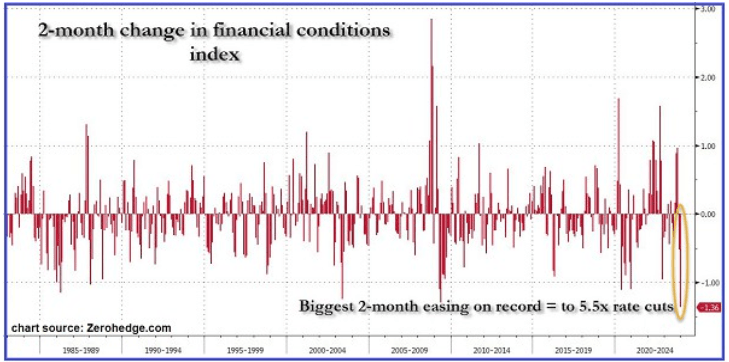Inok
The commentary below is from the January 12th issue of the Mining Stock Journal.
The stock market bubbled back up in 2023 because the Fed, despite a gradual reduction in its balance sheet, has been injecting liquidity in various forms into the banking system.
This occurred explicitly in March 2023 when it printed $400 billion to resuscitate the regional banks. The Bank Term Funding Program, though small relative to the Fed’s balance sheet, is another form of banking system liquidity.
There are some other “nooks and crannies” through which the Fed is injecting liquidity into the banks, but I believe the Fed will have to crank up the printing press again aggressively to fight both a banking system crisis and a debt crisis. This will be the fuel that propels the precious metals sector.
With respect to the Fed’s implicit pivot on its interest rate policy at the November FOMC meeting, systemic financial conditions eased in November and December combined by the greatest amount over a two-month period in the history of the metric:

This frenetic easing of financial conditions orchestrated by the Fed is the reason the precious metals sector outperformed the stock market in the last two months of 2023.
Between October 6th and year-end, gold ran from $1823 to $2071, or 13.6%. Similarly, silver ran from $20.85 to $23.76, or 14%. Over the same timeframe, the S&P 500 rose 10% and the Nasdaq climbed 11.8%. The mining stocks as represented by GDX jumped 15.3% over that time period.
I find it amazing that gold and silver outperformed the stock market while GDX outperformed the S&P 500 by 50% from early October through year-end, yet there was zero commentary to that effect from the mainstream financial media.
It is this anonymity factor with respect to the precious metals sector that makes it a textbook value investment play. This performance by gold, silver and the mining stocks should be well set-up by financial and economic tailwinds which will continue, if not intensify, in 2024.
Specifically, an examination of several individual bank quarterly financial statements reveals that the delinquency, default and charge-off rates are increasing at an increasing rate, particularly in commercial real estate and household debt.
For banks that emphasize consumer credit, like Synchrony, Discover and Capital One, the delinquency and default rates are much higher than the average across all banks. The rate of delinquency in subprime auto loans is higher than it was at the peak during the great financial crisis era.
This financial stress in the banking system is hidden in plain sight. It simply requires examining bank financial filings. But mainstream media reporters would rather just regurgitate the “banks are in good shape” propaganda fed to them.
For now, the financial stress at these banks has been subtly “papered over” by the Fed as described above. But at some point it will require considerably more liquidity creation than has been made available up to this point.
Hence, the probability is high that 2024 will witness the official rebirth of QE, though I’m guessing the Fed will label the program with something other than “QE” (something like current not QE-QE “Bank Term Funding Program”).
The only question in my mind is the scale and duration of the precious metals sector bull move that I believe will unfold over the coming months and quarters in response to the next stage of full-blown money printing.
In that regard, the Monetary Base (bank reserves plus currency/coin in circulation) has been rising since February 2023. This suggests that the Fed started injecting reserves into the banking before the regional bank crisis surfaced which indicates that the Fed knew what was coming.
The Monetary Base is up 9.5% since February 2023. Keep in mind that the Fed removed the reserve requirement for banks in 2020, which means that the increase in bank reserves per the Monetary Base creates a “multiplier effect” that is likely the reason behind the reflation of the stock bubble and dramatic drop in Treasury yields at the long end of the yield curve.
The point here is that, while it seems obvious that the Fed will need to crank up the printing press this year to keep the banking system solvent and to help fund the coming flood of new Treasury bond issuance, by some measures the Fed has already begun injecting liquidity into the banking system.
The rising Monetary Base is just one indicator, but it partially explains the unprecedented spike in financial conditions detailed above. Eventually, these monetary system developments will translate into much higher prices for gold and silver.
Editor’s Note: The summary bullets for this article were chosen by Seeking Alpha editors.



